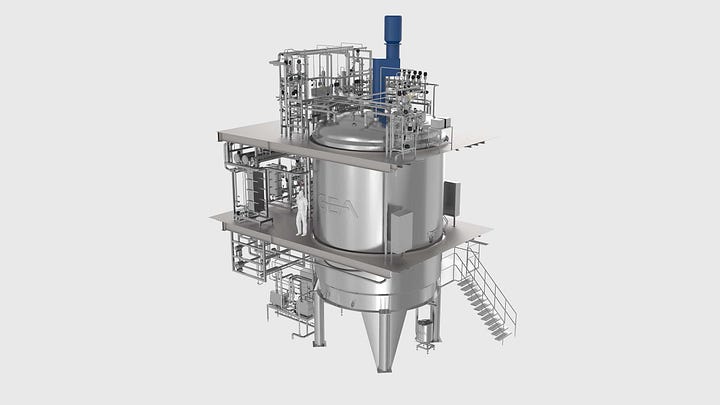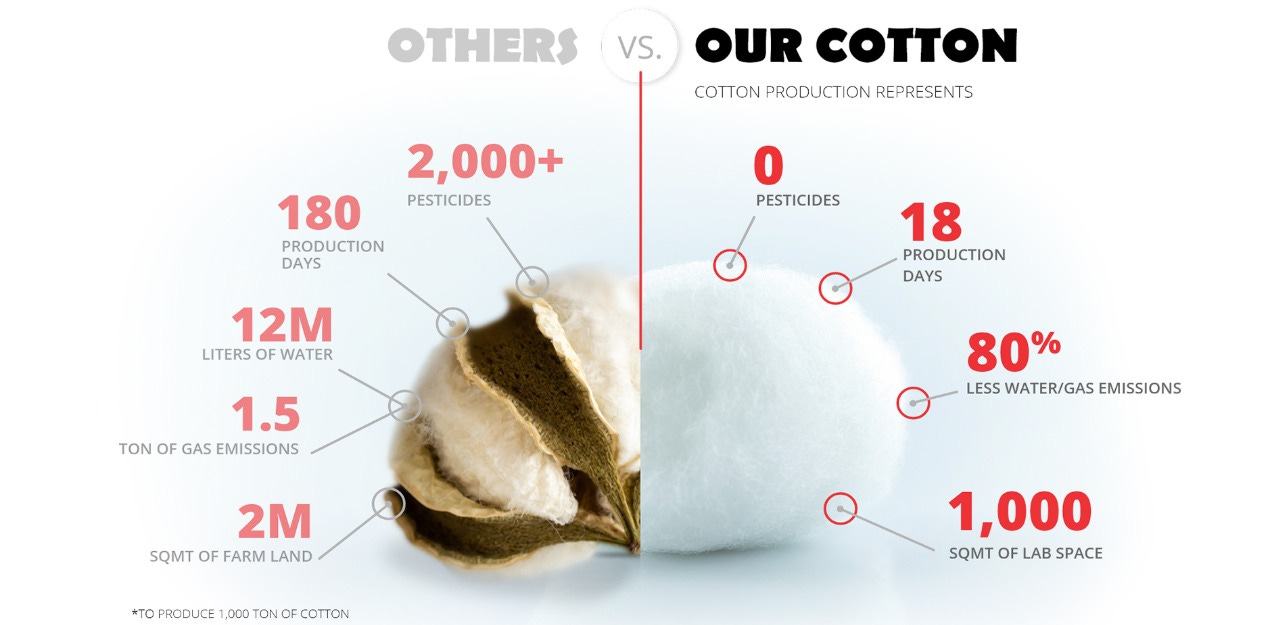Howdy, this is the 8th article of Fifth Industrial, a blog scouting emerging biotechnologies with potential to address biodiversity loss, climate change, animal abuse, and other maladies of the modern economy. See the landscapes on cellular agriculture, mycelium materials, synthetic silk, microbiomics, deep space food, alt cheese, and alt protein CPG.
I. What is plant cell culture?
Plant cell culture (PCC) is an emerging sub-sector of biomanufacturing where plant cells are grown in bioreactors, either to produce a purified biomolecule or entire cell as biomass. While most cellular agriculture utilizes yeast, bacteria, or mammalian cell lines as production strains, PCC utilizes plant cells or tissues as a broad-based production platform. Initially the domain of pharma, the tech is now being applied by about a dozen startups to make cosmetics, supplements, crop biologics, sweeteners, cocoa, coffee, and more.
PCC’s value proposition mirrors cultivated (cell-based) meat: rather than growing an entire plant (or animal) on farmland, you can grow select cells in a clean steel tank like a brewery. Also like cultivated meat technology, plant cell culture technology at least partly sprouted from decades-old work of the biomedical industry. For example, Taxol, a major cancer drug discovered in the 1960s, was primarily sourced from Yew tree bark. The collection process, however, killed the plant and landed it on the endangered species list, causing researchers to develop this clever biomanufacturing solution. Now, Taxol is sustainably produced through plant cell culture at industrial scales.
Note, PCC is a distinct technology from “plant molecular farming” (PMF), which has also sparked investor interest in the past two years. In PMF, transgenic plants — either in a greenhouse or on a field — serve as the bioreactors themselves. The target output (historically a pharmaceutical biomolecule) is then purified from the plant (historically tobacco leaves). About 20 companies are now producing casein proteins (e.g., Moolec, Mozza, Nobell), cell culture growth factors (e.g., Core Biogenesis, ORF Genetics, Tiamat), and other new targets from a variety of plant hosts such as soy, barley, wild flax, or fruits.
II. Why would we even want to grow plants in bioreactors? Why not?
The concept of plant cell culture sounds a bit ridiculous — why would we use an expensive industrial bioprocess to replicate a cheap, natural, easy process (growing plants)? Well, as it turns out, modern agriculture is often none of these things. Growing plants, especially in large scale monocultures, is one of the most destructive, resource-intensive, and risky activities that humanity engages in.
So why might PCC be a better alternative:
Efficient Production
Plant cells can be grown at all times and during all seasons without sunlight or agricultural land.
Some plants take decades to reach harvest maturity or are otherwise difficult to cultivate or harvest. Collecting saffron plant is a classic example — up to 150,000 of the flowers are and 40 hours of labor are required to yield 1 kg of the spice.
Food/Bio Security
Cell cultures are less susceptible to disruption from climate change, adverse weather, crop diseases, or land and water shortages.
PCC does not necessitate gene editing and the associated risks or regulatory issues (though it can leverage the technology if desired).
Precision Agriculture
We can grow cells from the most valuable part of the plant without growing low-value biomass which requires process and disposal. For example, we could grow flower petal cells without the leaves, stalks, and roots (typically farm waste).
The plant cells are housed in a self-contained system and fed a simple, defined media which can be recycled. So, we can obviate the need for most fertilizers, pesticides, and crop processing.
Sustainability
More research is needed, but preliminary LCAs find that PCC could use a fraction of the water and agricultural land, while imposing fewer externalities like soil depletion from tilling, water eutrophification from runoff, or use of toxic herbicides and pesticides that harm both wildlife and humans.
Ultimately, decoupling agriculture from land use could allow us to re-wild or reforest natural spaces, restoring major carbon sinks and sources of biodiversity. (The ‘rewilding’ movement is the most exciting development in conservation biology. Feral by George Monbiot is a fantastic read on the topic).
Creativity
With over 250,000 species of plants, there is an unbelievable biodiversity of phytochemicals and bioactive compounds to be explored. Some plants just can’t be produced through traditional agriculture. Some molecules can only be produced in a plant cell due to their unique physiology, so microbial fermentation or chemical synthesis aren’t a complete solution.
PCC could be used to conduct plant breeding with more precision and in a fraction of the time due.
See section III for a snapshot of what products labs and companies are researching.
What are the potential drawbacks of PCC?
We should be wary, but not dismissive, of the role that technologies like biomanufacturing can play in solving society’s worst issues, especially when there are obvious non-technological solutions like permaculture or government regulations.
Social
Techno-solutionism is most strongly resisted on social grounds by those whose livelihoods could be displaced by a new technology. Globally, there are one billion agricultural workers and cultural impacts to consider.
There could be serious hardship imposed, for example, on smallholder cocoa farmers in West Africa who are causing massive deforestation. These people, like those displaced by climate change, need social programs.
Techno-Economic
The industry seems to be at around TRL 5 or 6. There’s a non-zero risk that the technology will not succeed outside of existing pharmaceutical applications due to technical hurdles, legal barriers, or supply chain issues.
There is a global biomanufacturing capacity shortage, so any PCC producer will need to compete for bioreactors, talent, and space with the biopharma and broader cellular agriculture industries.
(Generally speaking) high unit costs due to relatively slow cell growth rates, modest titers, and sterilization requirements will preclude low-value applications of the technology, so it’s unlikely to be used to make maize of bananas, for example. If biomanufacturing costs continue to fall (like Moore’s Law), more becomes feasible.
Environmental
Typically, PCC entails taking a photoautotrophic organism and growing it in a liquid broth/media in a dark bioreactor of which there are several designs. This means, rather than surviving on sunlight (and soil), these plant cultures are usually fed exogenous sugars of which producing requires agriculture and pose its own environmental issues. Though, it’s worth noting that alternative feedstocks like starchy hydrolysates do exist.
Producers also need industrial equipment (steel and plastics) as well as electricity to run them. More life cycle analyses will be needed.


A standard bioreactor versus a photobioreactor. Sources: GEA, Etsy.
III. PCC Landscape: What is possible and who is doing it?
Commercial and research activity associated with PCC seems 3-5 years behind the animal cell culture and microbial cell culture spaces. Despite this, plant cell culture is starting to draw in some venture funding and is poised to become an industry in its own right due to its unique capabilities.
The technology can yield large amounts of plant cell biomass, but often the target of PCC is not the cells themselves, but rather secondary metabolites — specialized small molecules produced by the plants as natural antioxidants, pesticides, antibiotics, or other environmental coping mechanisms.
Known Applications
Tumor inhibitors (e.g., taxol, camptothecin)
Model organisms for research (e.g. calluses for plant cloning/micropropogation)
Cocoa — the future of chocolate is in jeopardy
Coffee — “the end of coffee” is possible
Vanilla — another “tropical bean” facing crisis
Cotton — even fluorescent cotton
Herbicides, fungicides, and pesticides — plants have waging chemical warfare for millennia
Flavors and fragrances — sweet proteins in particular can be many times sweeter than sugar
Nutritional supplements and cosmetic phytonutrients
Cannabis
Wood — Beyond medicinal barks, even 3D structured wood could eventually be produced through controlled tissue engineering approaches, as researchers at MIT are already testing. It is not a radically different idea than biofabrication with mycelium or growing bones. S/o to #woodgang.
Companies
Companies in the space include (alphabetically): Another, Ayana Bio, California Cultured, Celleste Bio, Chi Botanic, Ergo Bioscience, Galy, Geneus Biotech, Green Bioactives, Hefvin, ModernPharmLA Novella, Phyton Biotech.
As a platform
We’ve barely scratched the surface of what development and democratization of plant cell culture technology could mean. If successful, PCC could emerge as a bioproduction platform with transformational applications beyond drugs. Combined with advances in bioinformatics, synthetic biology, bioprospecting, co-culture, and biomanufacturing: plant cell culture would give society a versatile agricultural, material science, and speciality chemical production tool that leverages the unique biology and diversity of the plant kingdom.
Plant cell culture won’t solve the world’s urgent social and environmental issues, but if wielded responsibly could be a powerful tool that changes humanity’s relationship to the land and inches us towards the solarpunk future we hope for.





